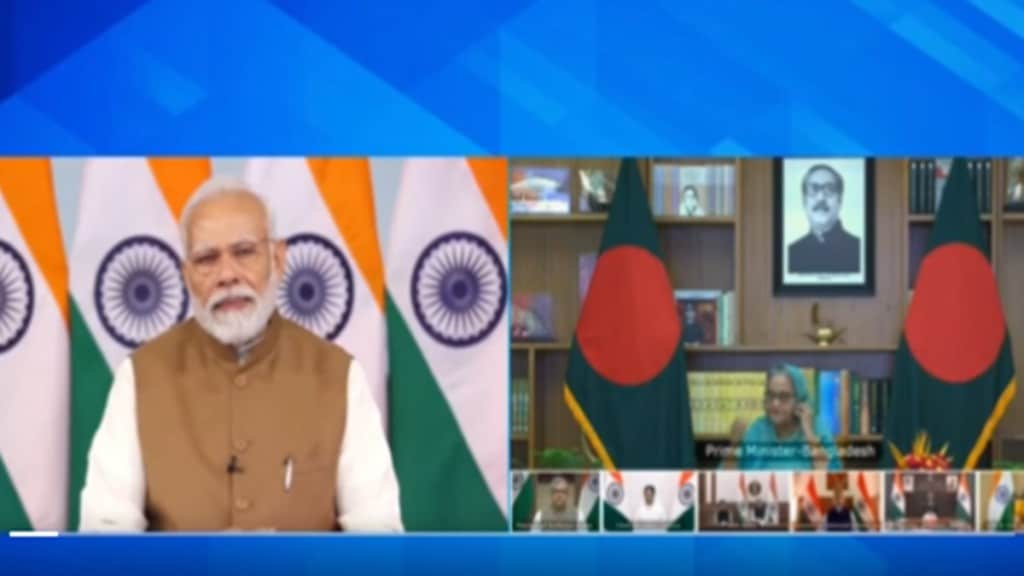India and Bangladesh have marked a significant milestone in their bilateral relations with the inauguration of three major connectivity and energy projects. These projects, unveiled during a virtual ceremony led by Indian Prime Minister Narendra Modi and Bangladeshi Prime Minister Sheikh Hasina, reflect the deepening ties between the two neighbouring nations.
The projects are the Akhaura-Agartala cross-border rail link, the Khulna-Mongla port rail line, and Unit II of the Maitree super thermal power plant. Each of these initiatives plays a crucial role in enhancing connectivity, trade, and energy cooperation between India and Bangladesh.
In recent times, Sheikh Hasina has faced growing pressure from opposition parties in Bangladesh and certain Western nations to ensure transparent and fair elections in the coming year. Under the leadership of Prime Minister Modi, India has emerged as Bangladesh’s largest development partner, providing substantial financial support through grants and concessional loans, totalling nearly US$10 billion.
Addressing the ceremony virtually, Prime Minister Modi highlighted the shared commitment of both countries to the development of infrastructure and connectivity, emphasizing that over the past nine years, India and Bangladesh have launched several new bus and rail services, opened immigration check posts, and introduced container and parcel trains, all of which have contributed to stronger ties and economic cooperation.
Prime Minister Hasina, speaking in Bengali, reiterated her government’s vision to create an advanced, prosperous, and smart Bangladesh by 2041. She also expressed her appreciation for India’s ongoing support in making this vision a reality, mentioning the construction of 12 IT parks with Indian assistance and the agreement to link payment gateways.
Neighbourhood First
For India, Bangladesh holds a pivotal position in its “Neighbourhood First” policy. Many development projects undertaken with Indian assistance are geared toward enhancing connectivity between Bangladesh and India’s strategically important and landlocked northeastern region.
One of the key highlights of these projects is the Akhaura-Agartala cross-border rail link, which connects India’s northeastern states to Bangladesh by rail for the first time. This development opens up new opportunities for trade, tourism, and improved connectivity between Bangladesh’s Chattagram port and India’s northeast.
The rail link connects Bangladesh’s Gangasagar station on the Dhaka-Chattagram line to Nischintapur station in Tripura, covering a total length of 12.24 kilometers. The project was successfully completed at a cost of US$150 million, which includes 6.78 kilometers of dual gauge line in Bangladesh, financed by an Indian grant of approximately US$50 million.
The Khulna-Mongla port railway line, spanning 64.7 kilometers, represents another milestone by connecting Bangladesh’s second-largest port to the country’s rail network for the first time. This connection also extends to India through the Petrapole cross-border rail link, with the project cost totalling US$380 million, covered by an Indian line of credit.
The Maitree super thermal power project is particularly significant, as it is built under an Indian concessional financing scheme loan of US$1.6 billion. This 1,320 MW power plant, located in Bangladesh’s Khulna division, aims to meet the increasing energy demands of the region, contributing to energy security in the neighbourhood. Unit II of the project was inaugurated on the same day as the virtual ceremony, following the launch of Unit I in September 2022. The project’s implementation is a joint venture between India’s NTPCL and the Bangladesh Power Development Board, known as the Bangladesh-India Friendship Power Company Private Limited, with both entities sharing a 50-50 partnership.
Prime Minister Modi, in his address highlighted the significant strides made in resolving long-standing land and maritime boundary disputes, which have resulted in enhanced peace, security, and stability along the borders. Both countries have also made considerable progress in developing their inland waterways to facilitate the movement of passengers and goods.
Connectivity between India and Bangladesh
The connectivity initiatives between Bangladesh and India have proven invaluable during the Covid-19 pandemic, with more than 4,000 tonnes of liquid medical oxygen transported to Bangladesh. The inauguration of the Akhaura-Agartala rail link is a historic moment, as it establishes the first rail connection between India’s northeastern states and Bangladesh. The Khulna-Mongla rail link, on the other hand, promises to boost trade between Mongla port and key trade centres in Dhaka and Kolkata.
Prime Minister Modi also underscored that the northeastern state of Tripura has been exporting 160 MW of power to Bangladesh since 2015, a testament to the collaborative energy cooperation. In addition, the first cross-border high-speed diesel pipeline was inaugurated in March of the same year, further reinforcing Bangladesh’s energy security and its journey toward self-reliance.
India’s approach, encapsulated in the slogan “sabka saath, sabka vikas” (inclusive development for all), has been extended to its closest neighbours, including Bangladesh.
Prime Minister Hasina pointed out several key steps taken by her government to enhance connectivity and boost trade between Bangladesh and India’s northeastern states. She mentioned the opening of Chattogram and Mongla sea ports and Chattogram airport for use by India. A rail service has been launched on the strategic Padma bridge, and a new tunnel under the Karnaphuli River is set to increase the capacity of Chattogram port.
This collaboration has not only ensured peace and stability in India’s northeastern region but also serves as a global example of how strong relations with a neighbour can drive bilateral progress and contribute to the prosperity of both nations. The India-Bangladesh partnership is a testament to the power of cooperation and a brighter future for the region.
